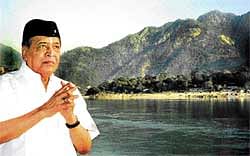
A singular thought was searing across minds as they stood in thousands at Guwahati airport for a final glimpse of their beloved musical icon, Bhupen Hazarika. All his life this musical genius had won over hearts by music no doubt, but more importantly, by his genuine nature: no trace of irresponsible tantrums and none of that cultivated musical mystique so often seen among performers of lesser ilk. Indeed Bhupen Hazarika, through his music, celebrated people, celebrated rhythm and people’s concerns by airing them in his golden lyrics and rendering them in baritone depths and chaste diction.
The beginnings of this musical journey had begun at age 12, when his voice still maintained the qualities of a distinct soprano timbre as he sang the number for the Assamese film Indramalati in 1939. Thereafter, he rose to be a local celebrity, a much sought-after performer at Assam’s bihutulis or gatherings at Bihu festivals, where the lamp-lit stage created the right ambience for those romantic favourites appropriate for the moment. Thereafter, the singer had journeyed to the USA in pursuit of higher studies when a meeting with the famous American spiritual singer Paul Robeson was to alter his approach to music altogether. He had associated with the artist in the mid-50s and even in New York had distinguished himself as being the best interpreter of India’s folk songs which had won him a medal at the hands of Eleanor Roosevelt. Back in India and while living in Shillong, he had carried back that ditty as part of his musical baggage so that when he was appointed programme assistant at the All India Radio Shillong Station, says Kyndoh the then station music director, “He loved to sing Old Man River, a Negro Spiritual made famous by Paul Robeson, a great Black singer of that time.”
Back in India, more than humming and singing the Robeson selection, Hazarika had switched from being a singer of romance-filled ditties to making music that was socially relevant. His music became the voice of concerns that were socially relevant and his all-time favourite signature song undoubtedly became Ganga, fashioned after Old Man River, according to some observers. The telling refrain, nishabde nirobey… depicting the silent and deep-set nature of the mighty river, conveyed more than a visual image. The river in his music became a symbol of the mother figure and her intense capacity to collect, absorb, wash away and internalise all that crosses her path till she flows to her ultimate salvation towards the sea. The music score was a flavour of the Negro Spiritual of his musical guru Robeson, but the emotions and feelings behind the words were of Bhupen’s making. He expressed anger at the river not airing her trauma and thereby questioned the plight of the silent sufferer pitted against a cruel society. The ultimate flowing of the river to its ultimate destination rounds up the song both musically and symbolically.
But not quite… Bhupen Hazarika’s repertoire was to discover fresh openings. He began to use his native Assamese lyrics that had risen to be heart throbs by then, with fresh makeovers. In the film Rudaali, which had catapulted him into a recognised and much-feted film producer, he had used the score of the original Buku hom hom in Assamese to create the magic of the number Dil hum hum that has become synonymous with the film. In a masterly way, this singer-poet had used his genius to touch hearts and minds with caressing tenderness.
Besides individual numbers that have become a part of musical heritage in India, there were numerous compositions and lyrics that eulogised the beauty of nature in Assam. These numbers were a shift from the earlier western influenced airs and were an offshoot of his deep-set knowledge of folk airs of the region, particularly Kamarupiya Lokageet, the folk music of Kamrup. His numbers rang out the majesty of the region’s rivers and of evenings serenading the scenes in his beloved city Shillong.
The Tirap frontier Beauty without compare Noctes and the Wanchoo Tangsas and the Yougli
In them I saw the farthest green horizons.
Thus his rivers were no longer mere geographical listings but carried forth a brilliant and colourful illustration of the scenic wonder of green banks and flowing waters.
Even when he spoke of social concerns, the link with nature was severed altogether. The River Luit or Brahmaputra was the mother river of his original composition on the Ganga which, taken at its surface, appears to be elucidating the sights and sounds of the waters. Only in its deeper meaning does it mirror social concerns. Similarly, in the film Aparoopa, the concerns of people are mirrored through descriptions of the passage of the seasons and its corresponding hues.
Yet, he never allowed his social conscience embitter his music into angst, belting out his anger in strident terms. The musical essence remained undistilled, no matter how aggravating its subject matter. His form of internalising the cause and thus reaching out to his audiences was through the complexities of rhythm, song quality and political commentary. For him, rhythm was subjected to the words they conveyed, as is evident in his number Dolah or palanquin gait, where he sings out the word dolah to the same rhythm as the gait of a palanquin bearer carrying his burden. For making music an instrument of social change, he was honoured at the Berlin Conference of Composers and when Bangladesh gained liberation, Hazarika was at the inauguration of a world seminar where he sang his own compositions on that historic moment in the subcontinent.
This is a singer who was as much at ease singing in Bengali as in Assamese, in Hindi as in English, so that the bard is understood and appreciated across the length and breadth of the country. Music lovers take pride in claiming him as their own and Assam has been able to share this musical genius with the rest of the country in a deserving manner.